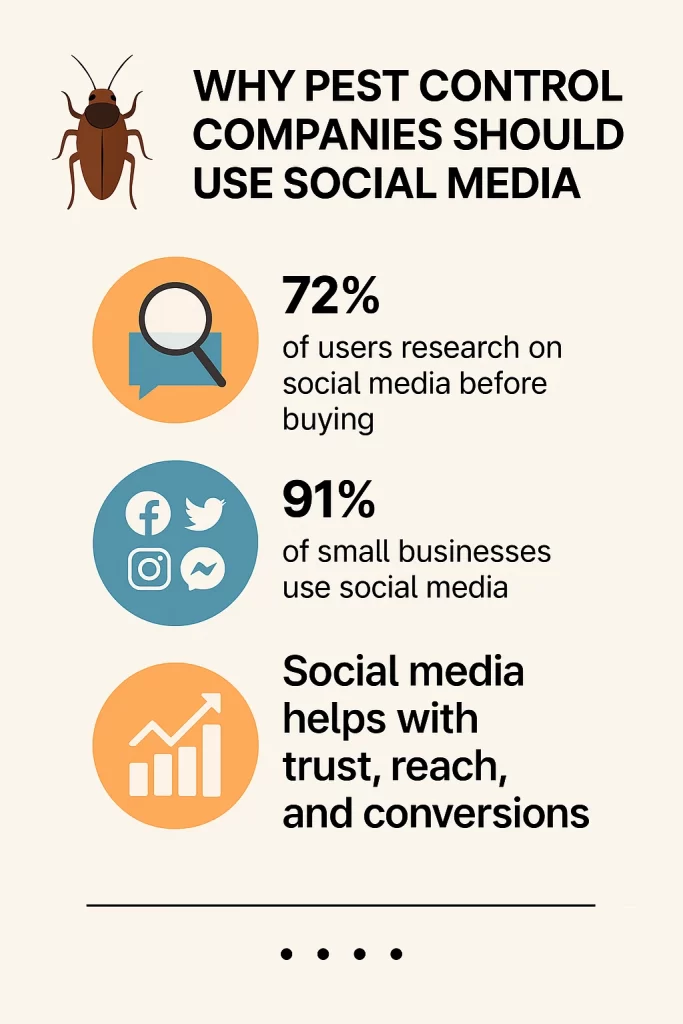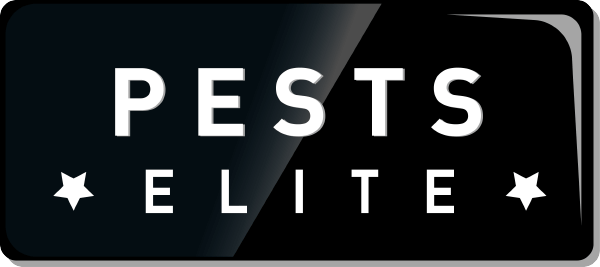In a competitive industry like pest control, simply relying on word-of-mouth or local listings isn’t enough. More than 72% of consumers use social media to research brands and services before making a decision (Datareportal). If your pest control business isn’t visible or active on platforms like Facebook and Instagram, you’re likely missing out on valuable leads.
This blog will show you how to leverage social media to boost your pest control business, engage with your local audience, and generate a consistent stream of high-quality leads.
Why Pest Control Companies Should Use Social Media

Social media has evolved into more than just a platform for sharing photos—it’s now a powerful marketing tool. For pest control businesses, it offers a direct line to local homeowners and renters who may need your services urgently or seasonally.
According to Statista, 91% of small businesses use social media for marketing, citing increased exposure and traffic as the top benefits. With strategic use, platforms like Facebook and Instagram can:
- Boost brand awareness in your service area
- Help establish authority and trust through reviews and testimonials
- Allow precise targeting through ads (by zip code, interests, and behavior)
- Provide a space to educate potential clients on pest issues and prevention
- Drive qualified traffic to your website or booking platform
Actionable Strategies to Use Social Media to Boost Your Pest Control Business
Set Clear Goals for Your Campaign
Before posting anything, define what success looks like. Do you want more phone calls? Website visits? Booked appointments through DMs? Having clear objectives helps you:
- Choose the right platform (Facebook for leads, Instagram for brand awareness)
- Create posts with stronger calls-to-action (e.g., “Book Now,” “Call Today”)
- Measure ROI based on real outcomes, not vanity metrics
Identify Your Ideal Local Audience
Use Facebook’s Audience Insights or Meta Ads Manager to learn who your potential customers are. Are they homeowners aged 30–60? Are they in recently built neighborhoods with high termite activity? The more you understand their lifestyle and pain points, the more effective your campaigns will be.
Key targeting attributes may include:
- Homeownership status
- Marital or family status (parents often worry about pest safety)
- Zip codes with known pest problems
- Behavioral data, such as DIY interest or home improvement activity
Create Engaging, Educational Content
Don’t just post promotional material. Focus on solving problems and educating your audience.
Post ideas that work well for pest control:
- “What Attracts Roaches to Your Kitchen (And How to Stop Them)”
- “Top 5 Signs You May Have a Termite Infestation”
- “Is DIY Bed Bug Removal Effective? Pros and Cons”
Mix up your content formats to keep your page engaging:
- Short videos demonstrating pest entry points
- Infographics comparing DIY vs. professional services
- Before-and-after photos of real treatments
Consistency is key. Aim for at least 3–4 posts per week.
Showcase Real Customer Stories & Reviews
Social proof plays a huge role in converting leads. Share testimonials, before-and-after images, or short interviews with satisfied customers (with permission).
A few smart ways to do this:
- Create “Customer Spotlight” posts with a brief success story
- Share screenshots of Google or Yelp reviews
- Post user-generated content from happy clients tagging your service
📊 According to BrightLocal, 87% of consumers read online reviews for local businesses and most trust them as much as personal recommendations.
Use Facebook & Instagram Ads Strategically
Both platforms offer highly customizable ad features for local service businesses. Use them to:
- Retarget visitors who checked your website but didn’t convert
- Promote seasonal packages like mosquito control in summer or rodent-proofing in fall
- Offer exclusive deals for new followers or first-time clients
Pro tip: Run A/B tests with different images, headlines, and calls to action. This helps you learn what resonates best with your local audience.
Ad types that work well for pest control:
- Video walkthroughs of treatments
- Carousel ads showcasing different service packages
- Lead form ads to capture interest directly on Facebook without a landing page
Engage Through Comments and Messaging
Being responsive is non-negotiable. Social media users often expect near-instant replies.
- Respond to all comments within a few hours
- Set up automated replies on Facebook Messenger to acknowledge inquiries during off-hours
- Use quick reply buttons in DMs (e.g., “Book an Inspection” or “Ask About Prices”)
Offer Time-Sensitive Discounts and Seasonal Tips
Urgency boosts action. Promote deals tied to local seasons or current pest threats.
Example posts:
- “Got Ants After the Rain? Book Now and Get $20 Off!”
- “Spring Cleaning Special: Free Rodent Inspection This Week Only!”
Pair these with relevant visuals, such as pests that spike during a season or areas commonly affected in your city.
Monitor Performance & Optimize Regularly
Don’t just post and forget. Use Meta Business Suite or third-party tools like Hootsuite or Sprout Social to monitor metrics like:
- Engagement (likes, shares, comments)
- Click-through rates (on ads or bio links)
- Booking and message conversion rates
If a certain post format or topic is getting better reach or leads, double down on it.
Leverage Local Hashtags and Geo-Tagging
Want to show up in local discovery feeds? Use relevant hashtags and geotags.
Examples:
- Hashtags: #OrlandoPestControl, #PhoenixTermiteTreatment, #BugFreeBoston
- Geo-tags: Tag neighborhoods or city names in Instagram posts/stories
This increases your visibility when people search for services in your area.
Collaborate with Local Influencers or Businesses
Local collaboration builds trust and reach. Consider:
-
- Partnering with real estate agents to offer pest inspections during closings
- Doing joint giveaways with home cleaning or lawn care businesses
- Paying micro-influencers (local bloggers or community pages) to promote your service with a live demo
- Partnering with real estate agents to offer pest inspections during closings
Conclusion
If your pest control business isn’t leveraging social media, you’re leaving leads on the table. Facebook and Instagram offer powerful, affordable ways to connect with your ideal audience, build trust, and convert interest into appointments.
Start with small, measurable goals. Test different content types, stay consistent, and adjust based on performance. Over time, you’ll build a loyal, local following—and a healthier bottom line.


